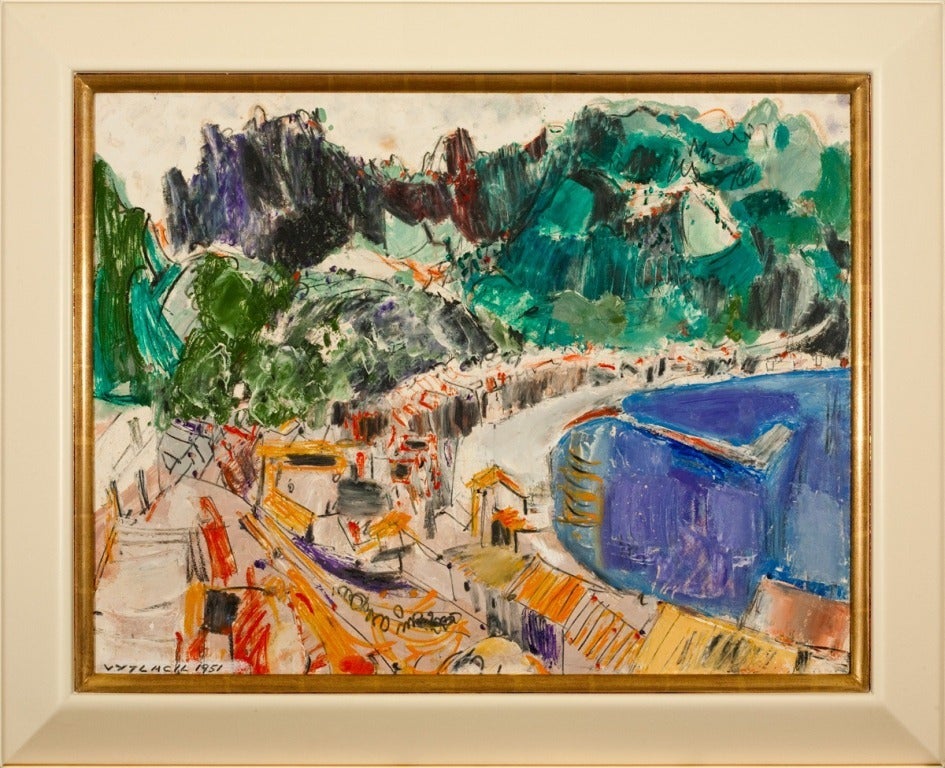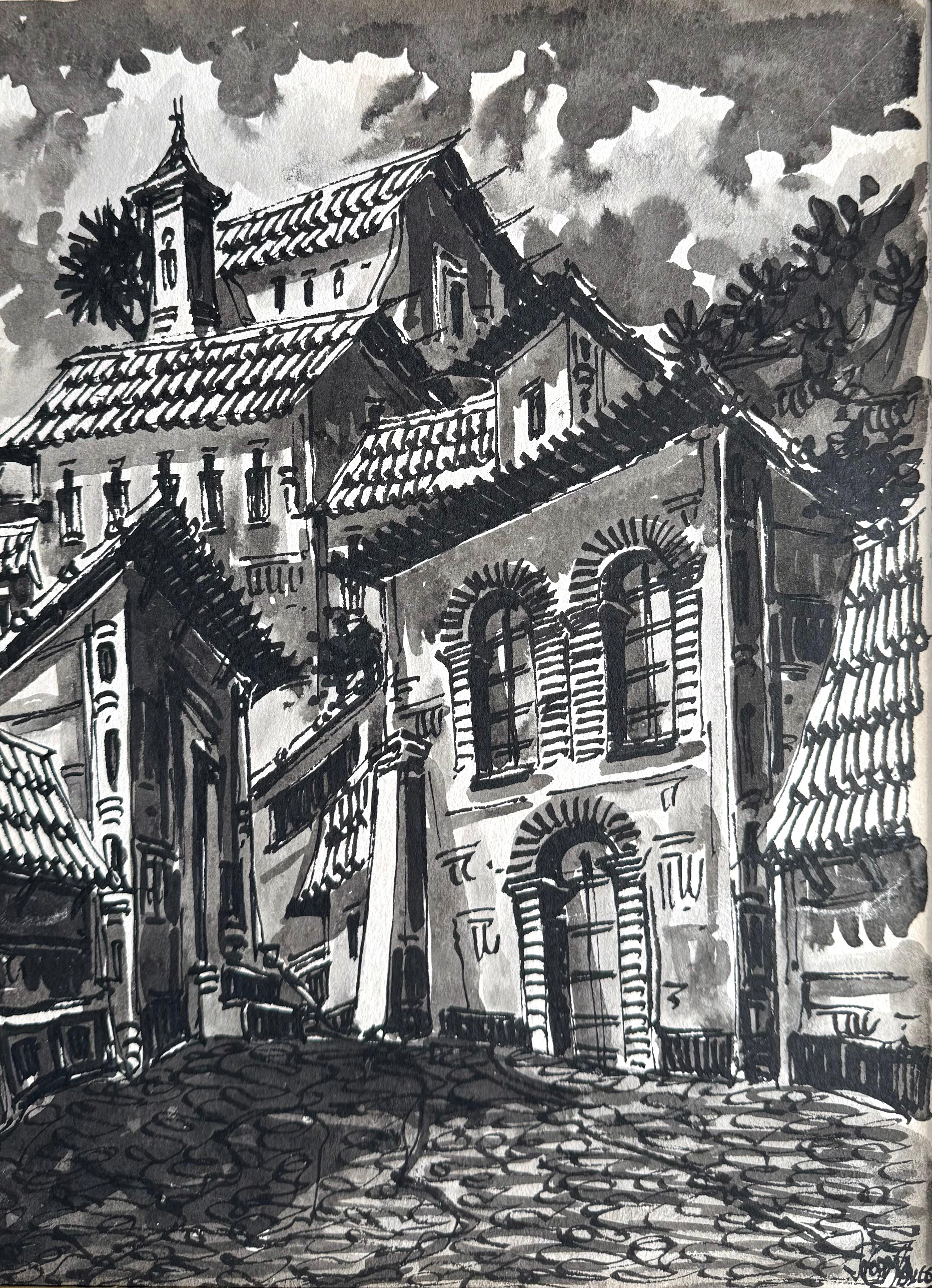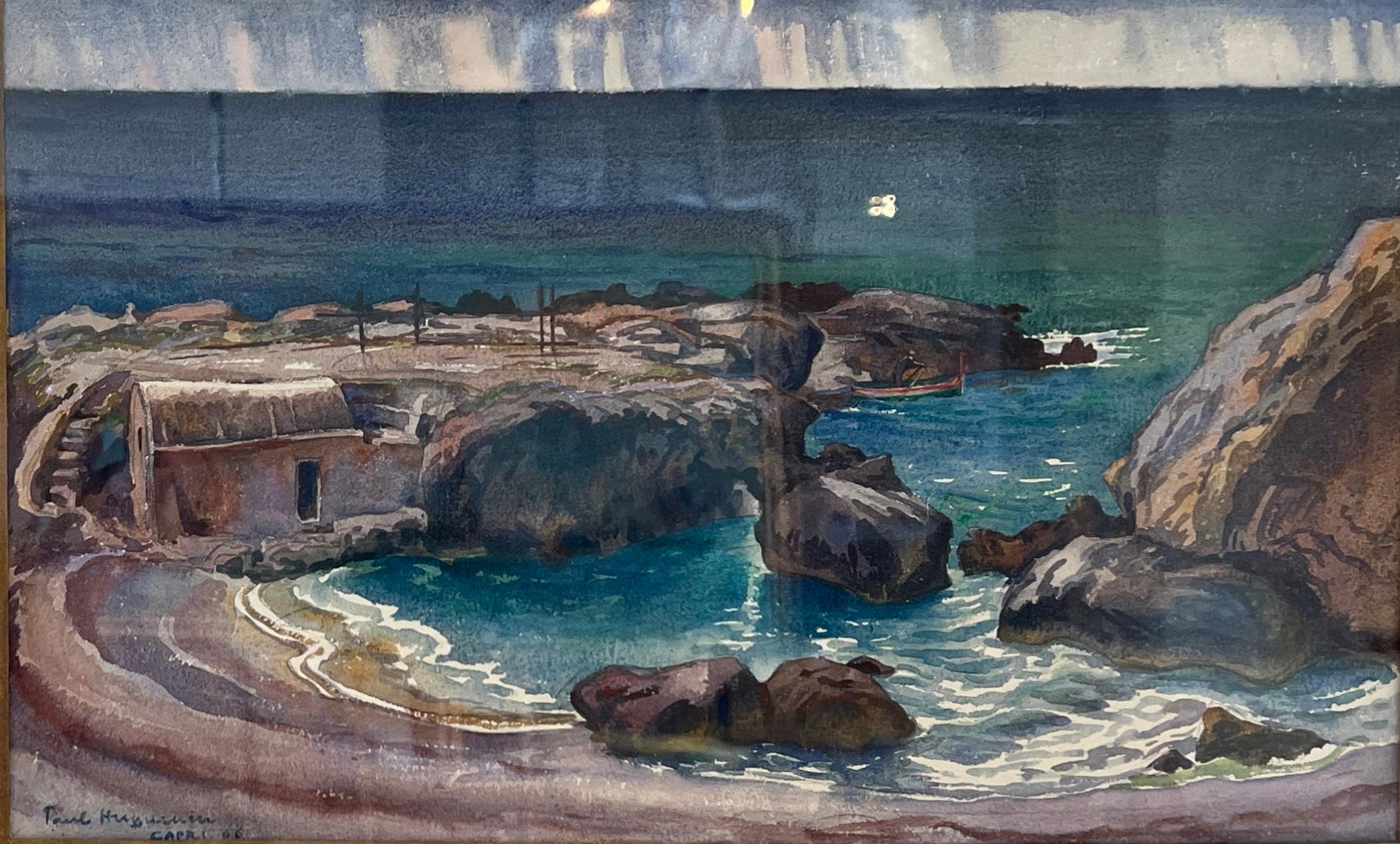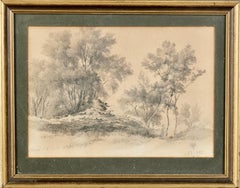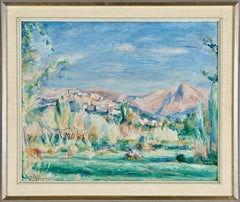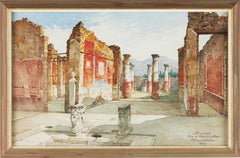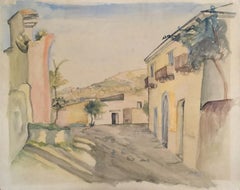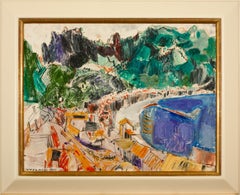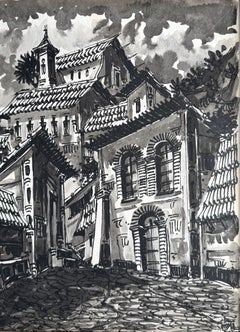Items Similar to Positano Village - Sepia Drawing 1920´s
Want more images or videos?
Request additional images or videos from the seller
1 of 12
Carl PalmePositano Village - Sepia Drawing 1920´s1921
1921
$1,728.21
£1,279.73
€1,450
CA$2,376.55
A$2,643.33
CHF 1,383.46
MX$32,239.96
NOK 17,383.73
SEK 16,351.65
DKK 11,039.30
About the Item
A rare ink and watercolor drawing by Carl Palme, dated 1921 and signed “CP 21,” captures the intimate character of Positano’s narrow alleys. Measuring ca. 20 x 24 cm without frame. Inscribed on the back that it´s a preparatory study for a larger oil painting. Early 20th century works by Palme are scarce.
Carl Palme (1879–1960): Painter, Printmaker, and Cosmopolitan Artist.
He was born in Stockholm in 1879, the son of bank director Henrik Palme and Anna Lavonius. He grew up on the family estate of Svalnäs, now a guest home and senior residence. From an early age, Palme showed a sensitivity to both literature and art, interests that would later merge in his career as painter, draftsman, printmaker, and author.
His artistic education began in London at the Slade School of Fine Art (1900–1901), where he was introduced to modern European currents. From 1902 to 1904, he studied in Munich at Wassily Kandinsky’s art school, absorbing early expressions of color and form. In 1907, Palme moved to Paris, where he became the first Swedish student of Henri Matisse. Together with fellow Scandinavian artists, he was instrumental in founding the Académie Matisse, a collective of young painters who rented a large studio in Paris. Matisse himself visited weekly, critiquing their work and shaping what would later become a decisive wave of modernism in Swedish art. Among the group were such notable names as Isaac Grünewald, Sigrid Hjertén, and Einar Jolin.
Palme traveled frequently to Positano, a village on the Amalfi Coast in Campania, Italy, not far from Naples. At that time, Positano was still a relatively remote fishing village built dramatically into the steep hillside above the Mediterranean. Its labyrinth of stairways and sun-drenched terraces inspired Palme’s drawings and paintings. Historically, Positano had been a flourishing port in the Duchy of Amalfi during the Middle Ages and a wealthy maritime town in the 16th and 17th centuries. By the 19th century, however, economic decline forced many inhabitants to emigrate. Tourism only began to transform Positano in the mid-20th century, especially after John Steinbeck’s famous 1953 essay brought international recognition. Palme’s depictions of the village thus capture it at a moment before its rediscovery, reflecting an intimate, authentic Mediterranean atmosphere.
In 1914, after meeting Emil Orlik in Berlin, Palme shifted his attention from painting to color woodcuts. He refined a personal method of carving multiple woodblocks—one for each color—allowing him to create highly nuanced, layered prints. This medium became central to his later career, setting him apart from many of his contemporaries.
Palme exhibited regularly and his works are today represented in several major institutions, including the Nationalmuseum and Moderna Museet in Stockholm, the Gothenburg Museum of Art, Malmö Museum, and Prince Eugen’s Waldemarsudde. His 1950 book, Konstens Karyatider, offered a humorous and reflective account of his travels and artistic experiences across Europe, while also providing unique insights into his pioneering color woodcut technique.
From 1933 until his death in 1960, Carl Palme lived and worked at Villa Fostorp in Katrineholm, continuing to paint, write, and experiment with printmaking. His legacy rests on his cosmopolitan vision, his role in introducing modernist impulses to Sweden, and his distinctive contribution to the art of the woodcut.
- Creator:Carl Palme (1879 - 1960, Swedish)
- Creation Year:1921
- Dimensions:Height: 16.93 in (43 cm)Width: 17.72 in (45 cm)Depth: 0.79 in (2 cm)
- Medium:
- Period:
- Condition:The drawing is in good condition. A change of the passepartout and frame is recommended. We can arrange a new passepartout as a complimentary service.
- Gallery Location:Stockholm, SE
- Reference Number:1stDibs: LU2608215869412
About the Seller
5.0
Gold Seller
Premium sellers maintaining a 4.3+ rating and 24-hour response times
1stDibs seller since 2023
25 sales on 1stDibs
Typical response time: <1 hour
- ShippingRetrieving quote...Shipping from: Stockholm, Sweden
- Return Policy
Authenticity Guarantee
In the unlikely event there’s an issue with an item’s authenticity, contact us within 1 year for a full refund. DetailsMoney-Back Guarantee
If your item is not as described, is damaged in transit, or does not arrive, contact us within 7 days for a full refund. Details24-Hour Cancellation
You have a 24-hour grace period in which to reconsider your purchase, with no questions asked.Vetted Professional Sellers
Our world-class sellers must adhere to strict standards for service and quality, maintaining the integrity of our listings.Price-Match Guarantee
If you find that a seller listed the same item for a lower price elsewhere, we’ll match it.Trusted Global Delivery
Our best-in-class carrier network provides specialized shipping options worldwide, including custom delivery.More From This Seller
View AllNarni Landscape - Drawing 1845
Located in Stockholm, SE
“Hilly landscape with trees and bushes from Narni in Italy,” sketched by Gustav Wilhelm Palm (1810–1890). Dated and signed “Narni 16 Sept” with “G.W [palm tree] 45,” it portrays gent...
Category
1840s Other Art Style Landscape Drawings and Watercolors
Materials
Paper, Pencil
Mountain Landscape with Haut de Cagnes - Oil on Panel 1920´s
Located in Stockholm, SE
An impressionistic portrayal of the village of Haut-de-Cagnes on the French Riviera, painted in vibrant colors. Oil on panel, signed and dated "F Berg 22", later frame. A tergo inscr...
Category
1920s Other Art Style Landscape Paintings
Materials
Oil, Wood Panel
Pompeii House and Vesuvius - Watercolor 1919
Located in Stockholm, SE
Watercolour with a captivating motif from Pompeii, with Mount Vesuvius in the background and, in the foreground, an interior view from the Casa di Cornelio Rufo. Signed and dated "Po...
Category
1910s Other Art Style Landscape Drawings and Watercolors
Materials
Paper, Watercolor
Pompeii House and Vesuvius - Watercolor 1918
Located in Stockholm, SE
Watercolour with a captivating motif from Pompeii, with Mount Vesuvius just visible in the background and, in the foreground, an interior view from the Casa di Marco Olconio, Pompeii...
Category
1910s Other Art Style Interior Drawings and Watercolors
Materials
Watercolor, Paper
Italian Landscape, Ariccia and The Alban Mountains - Oil on Paper 1850´s
Located in Stockholm, SE
View of the Ariccia Bridge and the Alban Hills
This finely executed plein air landscape depicts the monumental bridge of Ariccia and the town with the surrounding Alban Hills, painted by German landscape artist Joachim Ludwig Heinrich Daniel Bünsow (born 1821 in Kiel, died 1910 in the same city). Executed in oil on paper mounted on cardboard, the work dates from his Italian period between 1853 and 1858. Not signed.
Bünsow received his artistic training at the Royal Danish Academy of Fine Arts in Copenhagen from 1839 to 1848, studying under Johann Ludwig Lund and Christoffer Wilhelm Eckersberg. In 1844, the Copenhagen Art Association acquired his painting "Tellingstedt in Dithmarschen." Following his studies, he traveled to Dresden, where he became associated with the circle around Johan Christian Dahl. A scholarship from the Copenhagen Academy enabled Bünsow to reside in Rome from 1853 to 1858. During this period, his landscapes evolved from the finely toned, naturalistic style of his early work to more atmospheric and idealized compositions, influenced by Louis Gurlitt.
Bünsow's early works from his time in Copenhagen are characterized by fine tonality and naturalistic rendering, reflecting the style of his teacher Christoffer Wilhelm Eckersberg. His Italian landscapes, however, exhibit a more atmospheric and idealized approach, influenced by Louis Gurlitt. Notably, Bünsow produced high-quality drawings during his time in Rome, some of which are preserved in the Kunsthalle zu Kiel.
Historical Context: The Ariccia Bridge
In the early 19th century, the local authorities sought to improve the Appian Way's safety and accessibility. The solution involved constructing bridges to span the Ariccia valley and adjacent ravines. In 1843, Pope Gregory XVI commissioned a six-arched bridge to address the elevation differences. Following his death in 1846, Pope Pius IX continued the project, entrusting architect Ireneo Aleandri with the design and Giuseppe Bertolini with the execution.
Completed in 1854, the bridge stands as a significant 19th-century engineering achievement. Featuring three tiers of elegant neoclassical arches inspired by Roman art, it measures 59 meters in height and 312 meters in length. Travertine columns at both ends commemorate the Roman milestones...
Category
1850s Other Art Style Landscape Paintings
Materials
Paper, Oil, Cardboard
Moonlight Scene in Venice with Gondola - Watercolor 1920´s
Located in Stockholm, SE
Watercolor painting depicting a nocturnal scene of Venice, featuring a gondola gliding slowly through the water under a full moon, by Karl Bergquist. Signed and dated "K Bergquist Ve...
Category
1920s Other Art Style Landscape Drawings and Watercolors
Materials
Paper, Watercolor
$810 Sale Price
20% Off
Free Shipping
You May Also Like
Ischia - Watercolor on Paper by Léopold Survage
By Léopold Survage
Located in Roma, IT
Ischia is a beautiful watercolor on paper with soft eathly color tones of a glimpse into the town of Ischia. The piece was realized by Léopold Survage in 1947.
This unique piece is h...
Category
1940s Modern Landscape Drawings and Watercolors
Materials
Paper, Watercolor
"Positano Coast"
By Vaclav Vytlacil
Located in Lambertville, NJ
Vaclav Vytlacil (Vas-lav Vit-la-chil) was born in New York City in 1892 to Czech parents, but was raised in Chicago. He was an artist since boyhood, becoming the youngest student to ...
Category
20th Century Abstract Landscape Paintings
Materials
Board, Oil
“Taxco, Mexico”
Located in Southampton, NY
Beautifully executed black and white watercolor and gouache drawing on archival paper of the Spanish colonial town of Taxco, Mexico. Circa 1960. Condition is excellent. Signed low...
Category
1960s Contemporary Landscape Drawings and Watercolors
Materials
Watercolor, Gouache, Archival Paper
$460 Sale Price
20% Off
Positano, Amalfi Coast, Italy ' mixed media on paper, circa 2005
Located in Frome, Somerset
A fine piece from a series of paintings by Gradwell. This piece represents the sense of place throughout the Seasons. Light , time of day and weather. It's a very layered piece in mi...
Category
Early 2000s Modern Paintings
Materials
Mixed Media
$606 Sale Price
20% Off
'Amalfi, Italy', mixed media on paper c2005
Located in Frome, Somerset
'Amalfi, Italy'. Mixed media on paper . circa 2005.
painting 41cm x 54cm
glazed frame 62cmx 82cm
Atmospheric view of the seafront topography and buildings of the famous coastal town...
Category
Early 2000s Modern Landscape Paintings
Materials
Watercolor
Capri
Located in Genève, GE
Work on paper
Gilded wooden frame with glass window
66 x 71 x 2.5 cm
This painting depicts a magnificent coastal view of a rocky beach, incorporating a fascinating play of texture...
Category
Early 1900s Expressionist Landscape Paintings
Materials
Gouache
More Ways To Browse
17th Century Italian Drawings
Large Southwestern Painting
17th Century Village Paintings
Southwestern Watercolor Paintings
Sorrento Italy
Large 16th Century Oil Paintings
19th Century Oil Paintings Swedish
Art Positano Italy
Amalfi Painting
Kandinsky Woodcut
Amalfi Coast Painting
16th Century Woodcuts
Wassily Kandinsky Woodcut
Oil Painting Amalfi
Antique Alley
Amalfi Coast Oil Painting
Positano Painting
John Steinbeck Signed

